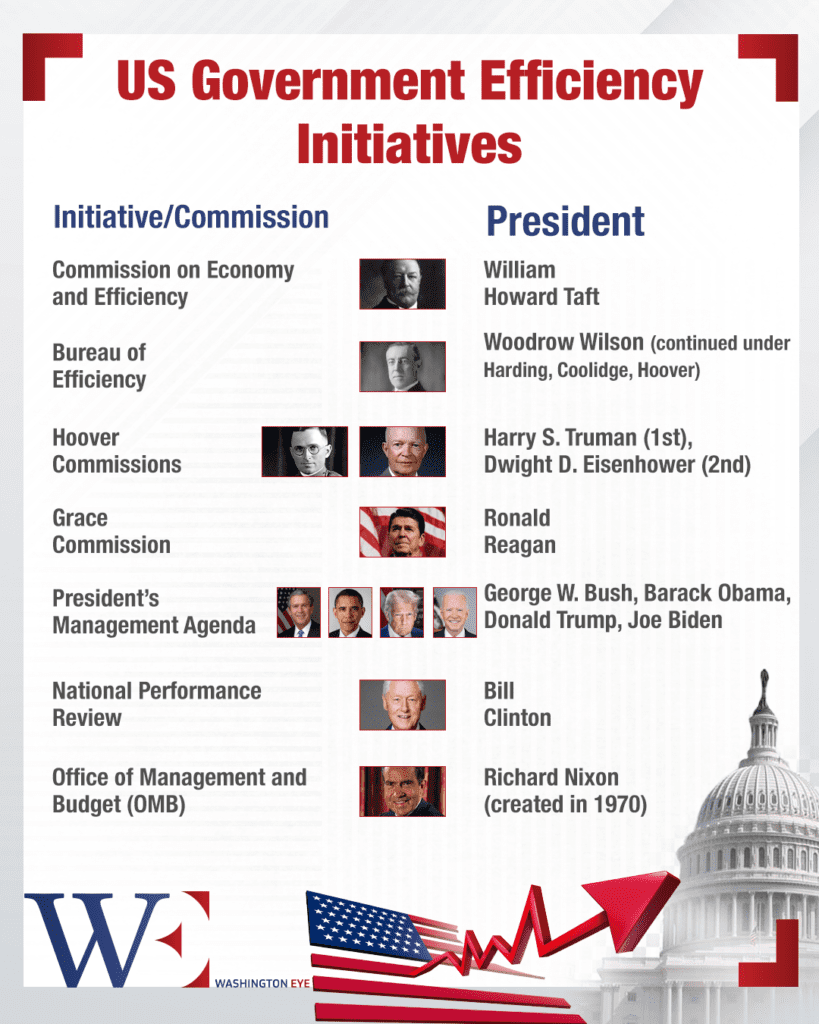For more than a century, U.S. presidents have sought to rein in bureaucratic waste, streamline government operations, and bring a semblance of order to the vast, often sluggish federal machine. From the Commission on Economy and Efficiency under President William Howard Taft to Ronald Reagan’s Grace Commission, countless committees, reviews, and agencies have taken up the noble yet Sisyphean task of making the government… actually work.
But never before has a government efficiency drive been quite as audacious—or quite as chaotic—as the Department of Government Efficiency (DOGE), established under President Donald Trump in 2024 and placed under the direction of Elon Musk. If past commissions tried to trim the fat, Musk’s DOGE seems intent on torching the entire meal prep kitchen.
So how does Musk’s fast-moving, tech-fueled, libertarian-tinged approach compare to the century-old struggle for government efficiency? And is DOGE an inspired masterstroke or bureaucratic demolition derby?
The Classic Approach to Government Efficiency: Commissions, Reports, and Shelf Dust
Before DOGE, government efficiency initiatives were solemn affairs, conducted by well-dressed committees who spent years compiling multi-volume reports that often went ignored by Congress. Among the most notable:
1. Commission on Economy and Efficiency (1910-1913)
- President: William Howard Taft
- Leader: Frederick A. Cleveland
- Goal: Introduce a national budget system and reduce inefficiencies.
- Outcome: Provided foundational ideas that influenced later budget reforms but largely got lost in the bureaucratic abyss.
2. Hoover Commissions (1947-1955)
- Presidents: Harry S. Truman (1st Commission), Dwight D. Eisenhower (2nd Commission)
- Leader: Former President Herbert Hoover (because apparently, nothing says “efficiency” like bringing back the guy blamed for the Great Depression).
- Goal: Streamline the executive branch, cut unnecessary agencies, and consolidate operations.
- Outcome: Created the General Services Administration (GSA) and strengthened the president’s ability to reorganize federal agencies. Estimated $3 billion in annual savings.
3. The Grace Commission (1982-1984)
- President: Ronald Reagan
- Leader: J. Peter Grace (CEO of W.R. Grace & Co.)
- Goal: Identify wasteful government spending and privatize inefficient federal services.
- Outcome: Recommended 2,000+ cost-cutting measures, estimating $424 billion in savings—most of which were never implemented due to Congressional inertia.
4. National Performance Review (1993-1997)
- President: Bill Clinton
- Leader: Vice President Al Gore
- Goal: “Reinvent government” by making it more customer-focused, tech-driven, and results-oriented.
- Outcome: 16,000 regulations eliminated, 250,000 government jobs cut, and $137 billion saved. One of the few efficiency drives that actually worked—until later administrations re-bloated the bureaucracy.
5. The Office of Management and Budget (OMB) (1970-Present)
- Created by: President Richard Nixon
- Goal: Centralize budget oversight and monitor federal agency performance.
- Outcome: Still active today, wielding some influence, but mostly reacting to inefficiencies rather than preventing them.
For all their good intentions, these commissions often found themselves bogged down by the very bureaucracy they were trying to fix. Enter Donald Trump and Elon Musk—men who prefer direct action over committee meetings.
DOGE: Elon Musk’s Efficiency Drive, Government Edition
In 2024, President Donald Trump launched the Department of Government Efficiency (DOGE), entrusting Elon Musk with the mission of making federal operations more efficient, tech-savvy, and, presumably, less boring.
DOGE’s Key Features Under Musk:
Tech Overhaul: DOGE prioritizes AI, blockchain, and automation, aiming to reduce human inefficiencies in government processes.
Regulatory Scorekeeping: DOGE maintains a “Unconstitutionality Index”, tracking how many agency rules are made by bureaucrats versus actual laws passed by Congress.
Office Closures: DOGE has terminated hundreds of federal office leases, aiming to save $500 million—though many agencies had no clue they were being evicted.
Federal Workforce Downsizing: Musk’s team has audited federal staffing, identifying redundancies (translation: layoffs incoming).
Transparency… or Not? Initially committed to publishing all spending cuts, DOGE later altered its reporting methods, making it harder to track what was actually being cut.
DOGE vs. Traditional Efficiency Commissions: Who Wins?
| Factor | Traditional Government Efficiency Commissions | DOGE under Musk |
| Leadership | Appointed officials & bureaucrats | Elon Musk, an actual billionaire |
| Decision-Making | Requires Congressional approval & years of study | Executive-driven, private-sector-style execution |
| Implementation Speed | Slow, cautious, often delayed | Lightning-fast, sometimes reckless |
| Transparency | Subject to oversight & public records laws | Initially transparent, later obfuscated |
| Challenges | Bureaucratic inertia, political resistance | Legal disputes, agency conflicts, potential overreach |
| Estimated Savings | Billions (often unimplemented) | Billions (though exact figures are unclear) |
Does DOGE Work, or is it Just a Musk-Tweet in Government Form?
While past efficiency commissions were often too slow to succeed, DOGE’s aggressive private-sector approach risks being too fast for government to handle.
The Good:
- If efficiency is the goal, DOGE delivers—slashing unnecessary regulations, cutting costs, and introducing tech solutions faster than any previous initiative.
The Bad:
- Conflicts with agencies (some were evicted from their offices without notice).
- Lack of transparency (DOGE’s spending cuts became harder to verify).
- Legal disputes (Congressional Democrats have raised concerns over Musk’s power within the executive branch).
So, What’s the Verdict?
Elon Musk’s DOGE initiative may be the most radical efficiency push in U.S. history, but whether it leaves a lasting impact or collapses under controversy remains to be seen.
If history has taught us anything, it’s that bureaucracy is like a Hydra—cut off one inefficient department, and two more grow in its place. But if Musk’s DOGE succeeds, it could rewrite the playbook for how government runs in the digital age.
At the very least, it’s already accomplished one thing no efficiency drive ever has before—it’s actually made government efficiency entertaining.

















